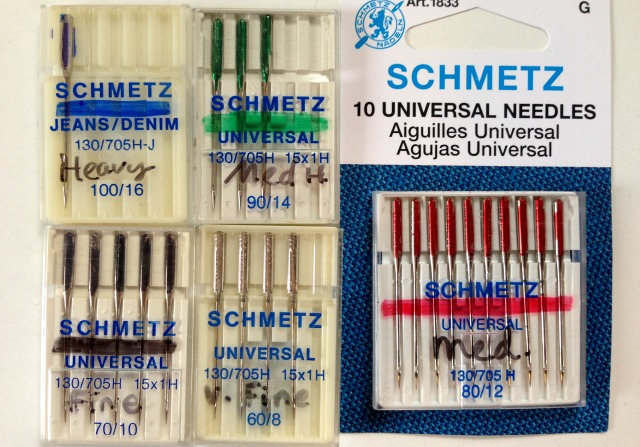
I like Schmetz needles mainly because they fit my New Home machine. However Singer has a smart color coding system going on for their needle types and sizes. I just had to borrow it.
Let’s get the background. There are different types of machine needles made for different types of fabric. A regular point needle is meant for woven cloth and may put a snag in your knit cloth. On knits you want to use a ball point needle. The rounded tip (still sharp, mind you) separates the threads of the knit fabric as it passes through; no snagging. And there are wedge point needles for leather and suede. I buy universal needles. They work on wovens and knits.
Then there are sizes of needles. On the needle packages you will usually see both the European metric sizes, 60 to 110, and the American sizes, 8 to 18. No matter which size system you follow, the smaller the number the smaller the needle. Smaller needles are for delicate fabrics and larger needles are for sturdier, heavier fabrics.
When I had a Singer machine, many years ago, their needles came with a color shank which identified the type and a second color band which told the user what size the needle was. Brilliant but unappreciated until I got my New Home machine and had to buy the shiny, minimalist, all one silver shaft, Schmetz needles.
Granted I switched needles over 23 years ago and had always wrote on the needle case the fabric weight it was meant for, heavy, med, fine, etc, but it was only recently, with my eyes requiring more and more assistance to make out the tiny, microscopic, imprinted needle size on the needle, that I thought why not color code my needles. Duh.

Sharpies to the rescue. I simply chose a color marker and marked the upper shaft of the needle and added a matching colored stripe to the needle case to remember which color I choose for which size. Tip: keep the colors distinct from each other. I noticed the blue sharpie on the needle has turned a little more purple from the heat it was exposed to while in the sewing machine. So blues could get mixed up with purples and reds with orange or fuchsia. I chose, red, blue, green, black and I left one size unmarked. If I buy size 110 needles I do not know what color I will mark it with. I wonder if yellow will show up.
There’s a better way to actually marking the needles I found out. One set of needles I marked while still in the plastic case. This was a bit messy. What seemed to work best was sticking the needles in a pin cushion and then marking the tops while they stood nice and still and free from other surfaces. They dry in a minute or less and when they do I just placed them back in their case. Oh, but the size 80 needle case was still attached to the cardboard display card. I simply bent the card like a tent, folded back the part of the plastic case that folds back and was able to mark the needle tops very easily (see top photo with card bent).
The color coding system is working great so far. Thank you to my art professors at the Corcoran School of Art who drilled into me that borrowing ideas, and turning them into your own, is never wrong. At least I think that’s what they meant.

I would use brown for leather
Smart. I did use blue for the denim or heavy needle.
My question is if the needles got mixed uo and tgere are no colours on them how can i determine their size?
If you have very good eyesight the needle size is stamped into the curved side of the shaft (the thicker top of the needle). It’s super small but it’s there.
You can try taking a picture with your cell phone, then zooming in to read the atomic-sized numbers. Borrowed the idea from an older beekeeper who was having trouble seeing the tiny bee eggs in his hives.
great idea, Shawn! I got to remember that